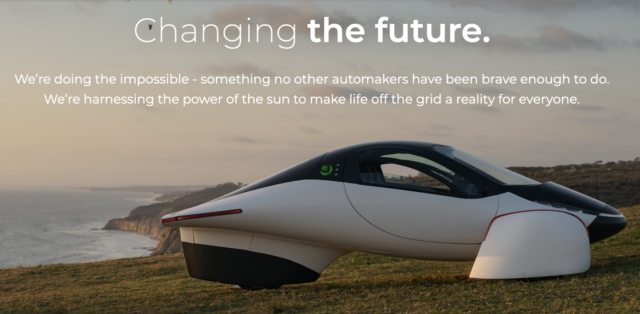Mission: To promote driving less so all may live more.
Finally, I found a car about which to be excited—in a positive way. (Yes, huge pickup trucks coming into my bike lane excite me also.)
Note: Too busy to read this post? I understand. In that case, you can click on the link below to save $30 on your Aptera reservation!
https://lz953.isrefer.com/go/preorder/a124831
The Aptera is not in production but the prototypes assure me that it will look similar to this:

Trust me, it’s not the space-age look that excites me…the look is largely the result of the wind-tunnel design that allows the vehicle to get incredible mileage. The Aptera is solar powered, so if you park it in the sun one day (easily done in Colorado), the battery receives 40-miles worth of power. That’s nearly free driving if the car’s already paid for (or if you steal one). The battery you charge can provide 1,000 miles before it needs a new full charge (preferably with a charging station unless you want to leave the car in the sun for 25 days). The gasoline equivalence of the Aptera’s efficiency is approximately 350 miles per gallon.
How do you buy one? There’s a waitlist. I’m in that queue: #78,145, expected delivery, 2025 (prob. Dec. 31 at 11:59). The reservation requires a $100 refundable deposit. I’m tempted to reserve a second one for reasons I cannot find. The car will cost me ~$33,000 according to the current estimation. I selected the 400-mile battery because I don’t want to drive 401 miles or more in one spell. Also, I ordered a custom color so that I could get a brightly colored car to help the huge pickup trucks see me.
I’ll end this post with a list of advantages and a couple of optional videos:
The Aptera is classified as a motorcycle/autocycle and therefore requires…
- a motorcycle license tag (cheaper)
- motorcycle insurance (cheaper)
But doesn’t require…
- a motorcycle driver’s license
Furthermore…
- It seats only two people but the lengthy aerodynamic tail provides comfortable sleeping space, better than most automobiles (I feel like a salesman at this point)
- It has an electric motor on each wheel which has advantages that I don’t understand
- The plan is to put a QR code on almost every part of the vehicle so that you can scan and order a replacement part, installing it yourself or taking it to a local garage
- It uses the Tesla charging hardware (which has now been adopted as the US standard)
- It has a 5-star crash rating
- It has all that smart-car stuff that will drive me crazy since I buy only manual transmission cars until now… but if you knock on the door or the trunk it politely opens automatically, etc.
- It has a very convincing CEO as the following 49 minute video will show. Although my son thinks all CEOs are convincing, he never worked for some of the ones I have, but this one is:
Here’s a fluffier video (21 minutes with a test drive at minute 12):
